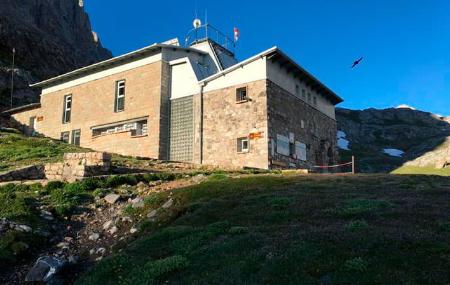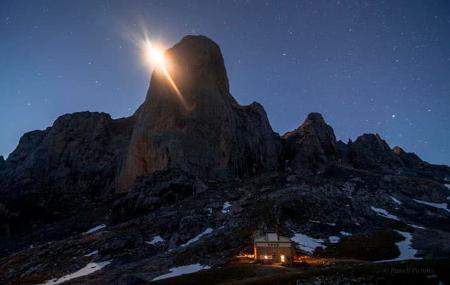
Vega de Urriellu Hut
- Mountain shelter
- Bed places Bed places: 96
- Address Cabrales Eastern Asturias
- Address Address: ■ 33554 - Vega de Urriellu. Macizo Central (Urrieles)
- Phone Phone: 984 090 981 | 638 278 041 | 650 780 381
- Email Email: refugiodeurriellu@hotmail.com
- Site Site: Visit
- Closed Closed: 16/12 a 14/03
Images
Info
At an altitude of 1,953 m, the present building was constructed during the summers and autumns of 1989-1990. The transport of materials was carried out by a "Chinouk" helicopter of the Spanish Army and other rented helicopters. It was inaugurated on 14th October 1990. Access from Collado Pandébano via La Terenosa and Collau Valleju follows a footpath that was opened in 1986, until then access from Cabrales was via Cambureru.
For the construction of the first refuge in the Vega de Urriellu, stone from the Vega itself was used. It had two floors: on the upper floor, which was accessed by an iron staircase and almost vertical, there was a continuous bunk bed with a capacity for nine people, which could be increased to fifteen, and on the lower floor there were wooden tables and chairs, shelves for cooking and folding bunks.The work began in the summer of 1953, the cement and beams were carried on shoulders from Puente Poncebos, through Bulnes, Cambureru and Jou Lluengu, over a height difference of 1,700 metres. In forty-seven days it was possible to close the waters and finish the main works at the end of September.
It was inaugurated on 5th August 1954, coinciding with the 50th anniversary of the first ascent of Picu Urriellu. In the following decade it became too small to receive the large number of climbers who sought its services and it was decided to extend it. The current refuge still has the complete façade of the previous one.
When the guard is not there, the refuge has 12 places with mattresses and water nearby.
Common amenities and services
-
Almohadas
-
Aseo
-
Breakfast served
-
Cocina
-
Colchones
-
Comedor
-
Dinner served
-
Heating
-
Lunch served
-
Nórdicos/Mantas
-
Radio socorro
How to get here
First Name: Vega de Urriellu Hut
GPS: 43.202866, -4.821304
Address: ■ 33554 - Vega de Urriellu. Macizo Central (Urrieles)




